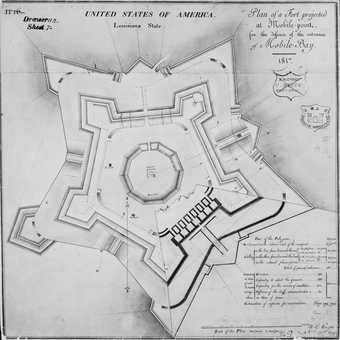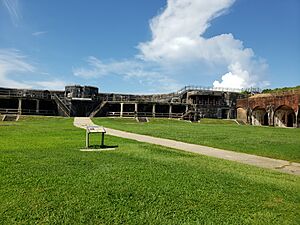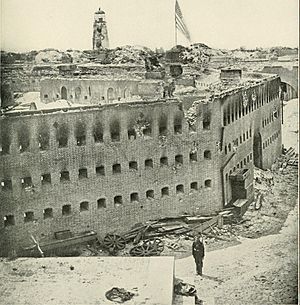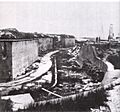Fort Morgan (Alabama) facts for kids
|
Fort Morgan
|
|

Original plan for the fort, dated 1817.
|
|
| Location | Western terminus of AL 180 Gasque, Alabama |
|---|---|
| Built | 1819–1834 |
| Architect | Simon Bernard |
| NRHP reference No. | 66000146 |
Quick facts for kids Significant dates |
|
| Added to NRHP | October 15, 1966 |
| Designated NHL | December 19, 1960 |
Fort Morgan is a very old and important fort located at the entrance of Mobile Bay in Alabama, United States. It's a huge, five-sided fort made of stone. The fort is named after Daniel Morgan, a hero from the American Revolutionary War.
This fort was built where an older, simpler fort called Fort Bowyer once stood. Fort Bowyer was involved in the last land battles of the War of 1812. Fort Morgan was finished in 1834 and welcomed its first soldiers that same year.
Fort Morgan sits at the very end of Mobile Point. It works with Fort Gaines on Dauphin Island to guard the entrance to Mobile Bay. The Alabama Historical Commission now takes care of this historic site.
Contents
Fort Morgan: A Historic Guardian
Fort Morgan has a long and exciting history. It played a big role in several wars, protecting the coast of Alabama. Let's explore its journey through time.
Early Days: Fort Bowyer and the War of 1812
After the Spanish left Mobile in 1813, the United States quickly built a small fort on Mobile Point. This fort was made of earth and wood and was named Fort Bowyer.
First and Second Battles of Fort Bowyer
In September 1814, British ships and soldiers attacked Fort Bowyer. The American soldiers inside successfully defended it in what was called the First Battle of Fort Bowyer.
The British came back in February 1815, after losing the Battle of New Orleans. This time, they attacked again in the Second Battle of Fort Bowyer. The American soldiers had to give up the fort. However, before the British could attack Mobile, Alabama, they learned that the Treaty of Ghent had been signed. This treaty officially ended the war. The British soon left, and it was clear that a stronger fort was needed to protect the bay. This led to the building of Fort Morgan.
Building a Stronger Fort
After the War of 1812, the U.S. government decided to build stronger forts along its coasts. In 1818, they hired Benjamin Hopkins to build a large stone fort on Mobile Point. The design came from Simon Bernard, a famous military engineer who worked for Napoleon.
Challenges in Construction
Building the fort was not easy. Hopkins died from yellow fever a year later. The next builder also passed away before much work was done. Finally, the United States Army Corps of Engineers took over. Captain René Edward De Russy made good progress, using enslaved laborers. When he got sick, Lieutenant Cornelius Ogden finished the fort in March 1834.
The Civil War: A Key Battleground
Fort Morgan became very important during the American Civil War. It was captured by Alabama volunteers just before Alabama left the United States in January 1861.
Protecting Mobile Bay
The Confederate soldiers quickly made the fort's defenses stronger. They placed 18 of the fort's biggest guns to aim at the main ship channel. This channel was the only way large warships could enter Mobile Bay. They also built trenches and small forts on land to stop attacks from that side.
The Confederates also had a small fleet of ships. These included the powerful ram ship Tennessee and three gunboats. Fort Morgan helped protect ships called "blockade runners" that tried to get supplies in and out of the bay. Most of these ships successfully avoided capture.
The Battle of Mobile Bay
On August 5, 1864, United States Navy forces, led by Admiral David G. Farragut, sailed past Fort Morgan into Mobile Bay. Farragut's fleet fought bravely, capturing two Confederate ships and forcing another to burn. They also captured Fort Gaines.
This victory allowed U.S. Army soldiers, led by Major General Gordon Granger, to surround Fort Morgan. After two weeks of heavy bombing from both land and sea, the fort's commander, Richard Lucian Page, surrendered on August 23, 1864. Before giving up, his soldiers made the fort's guns unusable by "spiking" them. This meant they hammered metal spikes into the firing holes so the guns couldn't be used.
The fort's main barracks, called the citadel, was badly damaged during the siege. After the war, its ruins were used as bricks to repair other parts of the fort.
After the Battle
Once back under U.S. control, Fort Morgan became a base for the U.S. Army. It was used to plan attacks on other Confederate forts, like Spanish Fort and Fort Blakeley. These battles happened just days before General Robert E. Lee surrendered, ending the Civil War.
Modernizing for New Wars
In the late 1800s, the U.S. government decided to update its coastal defenses again. A special group, called the Endicott Board, suggested building new concrete batteries.
New Guns and Batteries
Between 1895 and 1900, Fort Morgan received five new concrete batteries. These batteries had modern features like electricity and communication systems.
- Battery Bowyer: This battery had four large 8-inch guns that could hide when not firing. It was ready during the Spanish–American War. The guns were later removed in 1917 to be used as railway guns in World War I.
- Battery Dearborn: This battery had eight 12-inch mortars. Mortars fire shells high into the air, designed to land on the less protected decks of enemy ships.
- Battery Duportail: This battery held two huge 12-inch rifles on disappearing carriages. It was taken out of service in 1923.
- Battery Thomas: This battery had two fast-firing 4.7-inch guns. Its job was to stop smaller enemy ships from getting through the channel.
- Battery Schenk: This battery had three 3-inch rapid-fire guns, also protecting the ship channel.
The 20th Century and Beyond
The early 1900s brought new challenges and changes to Fort Morgan.
World War I and II Roles
Hurricanes in 1906 and 1916 caused a lot of damage to the fort's wooden buildings. In 1915, an experimental battery was built nearby to test new guns. The Navy even shelled it for two days to see how strong it was!
When the United States entered World War I in 1917, Fort Morgan became a training center. Soldiers learned how to use modern weapons and anti-aircraft guns. After the war, the fort was abandoned in 1924 and fell into disrepair.
However, in April 1942, during World War II, the Army came back to Fort Morgan. They built an airfield next to it and brought in new 155mm guns to defend the coast.
After World War II, in 1946, the U.S. government gave Fort Morgan to the state of Alabama. The Army completely left the fort in 1947.
Fort Morgan Today
Fort Morgan was recognized as a National Historic Landmark in 1960. This means it's a very important place in American history.
In 2008, workers found a 90-pound live cannon shell from the Civil War during repairs. It was fired by a U.S. Navy warship in 1864! Today, Fort Morgan is a popular place to visit, where people can learn about its amazing past.
Images for kids
See also
 In Spanish: Fuerte Morgan para niños
In Spanish: Fuerte Morgan para niños












